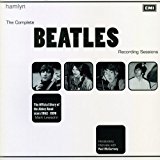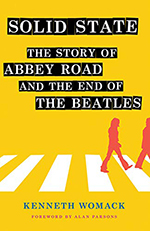- Album Songs recorded during this session officially appear on the Abbey Road LP.
- Studio:
- EMI Studios, Studio Two, Abbey Road
Timeline
More from year 1969
Some songs from this session appear on:
Spread the love! If you like what you are seeing, share it on social networks and let others know about The Paul McCartney Project.
About
On this day, from 2:30 pm to 10:30 pm, The Beatles started the recording of the last song for the “Abbey Road” album, John Lennon’s “Because“.
This was the first time John had brought the song to the other Beatles. The session started with a discovery phase where producer George Martin was much involved:
Everyone agreed that the song was begging for big, lush harmonies — just the kind of thing that was George Martin’s forte. Delighted to be contributing at last, he spent many long hours with John, Paul, and George Harrison gathered around the piano while he worked out their complex parts note by note.
First, though, a backing track had to be recorded, and George Martin was heavily involved in that as well. John had written the song on guitar, gently picking individual notes rather than playing chords, but he felt that something more was needed.
“Why don’t I double your line exactly on harpsichord?” George suggested, and Lennon quickly agreed. “Yeah, great, that will help make it a little more classical-like, too.”
Geoff Emerick – From “Here, There and Everywhere: My Life Recording the Music of The Beatles“, 2006
They then recorded 23 takes of the basic track (only takes 1, 16 and 23 were complete) and take 16 was considered to be the best.
John was on guitar (on track two), Paul played bass (on track one) and George Martin played an electric spinet Baldwin harpsichord (on track three). Ringo Starr kept time with handclaps for guide purposes only (on track four).
Take 1, with the handclaps audible, was released on the “Abbey Road (50th anniversary boxset)” in 2019.
On Because, for example, very much a John song, it needed the combined singing of the three men. So obviously it became a joint effort…
That particular track started off with John having the idea, the sort of riff on the guitar, which he played to me, and the basic song which he sang to me. And what we did then, we created a backing with him still playing the guitar, that riff, and I duplicated exactly every note that he played on the guitar, on an electric harpsichord, and Paul played bass.
And there was nothing for Ringo to do, because we’d not got drums in. But in fact there was something for him to do. Because it was so slow, and meticulously, the question of ensemble between the guitar and the harpsichord, each note had to be exactly together. And I’m not the world’s greatest player in time, and I would make more mistakes than John did. So we had Ringo beating a hi-hat all the time, to us in headphones, so we had a regular beat. We didn’t have drum machines in those days. So Ringo was our drum machine, and that was the way we did the track.
George Martin – Interview with Richard Buskin, 3 March 1987
Between us, we also created a backing track with John playing a riff on guitar, me duplicating every note on an electronic harpsichord, and Paul playing bass. Each note between the guitar and harpsichord had to be exactly together, and as I’m not the world’s greatest player in terms of timing, I would make more mistakes than John did, so we had Ringo playing a regular beat on hi-hat to us through our headphones.
George Martin – From “Insidetracks: A First-hand History of Popular Music” by Richard Buskin (1999)
So George Martin headed down into the studio, along with John and Ringo, while Paul and George Harrison stayed up in the control room. Ringo’s job was to act as a timekeeper, a human click track; he was merely to tap out a steady tempo on hi-hat, for reference purposes only. Hunched over their instruments, deep in concentration, they labored for a long time on that backing track. It wasn’t really their fault: Paul, who was acting as surrogate producer, was pushing them too hard that night, having them do take after take, playing way past their peak. When the exhausted trio finally came up to the control room to have a listen, they realized that they had laid down a perfectly good take an hour before. John didn’t say anything, but he shot an embarrassed Paul a dirty look. Fortunately, they seemed too tired to make an issue out of it.
Geoff Emerick – From “Here, There and Everywhere: My Life Recording the Music of The Beatles“, 2006 (Geoff Emerick contradicts George Martin by saying Paul didn’t contribute to the basic track but was in the control room)
Once the basic track was recorded, the process of overdubbing lead harmony vocals began.
Having done the backing track, John, Paul and George sang the harmony. Then we overlaid it twice more, making nine-part harmony altogether, three voices recorded three times. I was literally telling them what notes to sing.
George Martin – From “The Complete Beatles Recording Sessions” by Mark Lewisohn
On this day, John, Paul and John sang a three-part harmony added to take 16 (on track six). They would record two other sets of three-part harmonies on the next working day, August 4, 1969.
Last updated on January 12, 2022
Songs recorded
1.
Recording • Take 1
Album Officially released on Abbey Road (50th anniversary boxset)
Staff
Musicians on "Because"
- Paul McCartney:
- Bass, Lead harmony vocals
- John Lennon:
- Guitar, Lead harmony vocals
- George Harrison:
- Lead harmony vocals
- George Martin:
- Electric harpsichord
Production staff
- George Martin:
- Producer
- Geoff Emerick:
- Engineer
- Phil McDonald:
- Engineer
- John Kurlander:
- Second engineer
Going further
The Complete Beatles Recording Sessions • Mark Lewisohn
The definitive guide for every Beatles recording sessions from 1962 to 1970.
We owe a lot to Mark Lewisohn for the creation of those session pages, but you really have to buy this book to get all the details - the number of takes for each song, who contributed what, a description of the context and how each session went, various photographies... And an introductory interview with Paul McCartney!
Solid State: The Story of "Abbey Road" and the End of the Beatles
Acclaimed Beatles historian Kenneth Womack offers the most definitive account yet of the writing, recording, mixing, and reception of Abbey Road. In February 1969, the Beatles began working on what became their final album together. Abbey Road introduced a number of new techniques and technologies to the Beatles' sound, and included "Come Together," "Something," and "Here Comes the Sun," which all emerged as classics.
If we like to think, in all modesty, that the Paul McCartney Project is the best online ressource for everything Paul McCartney, The Beatles Bible is for sure the definitive online site focused on the Beatles. There are obviously some overlap in terms of content between the two sites, but also some major differences in terms of approach.




Contribute!
Have you spotted an error on the page? Do you want to suggest new content? Or do you simply want to leave a comment ? Please use the form below!